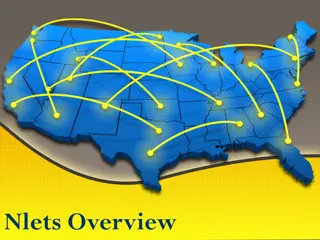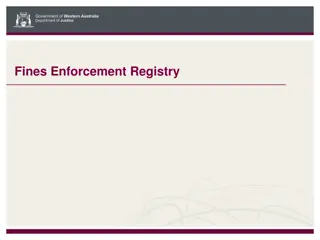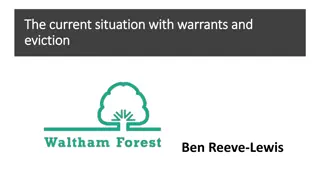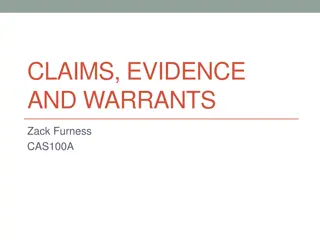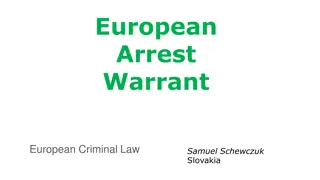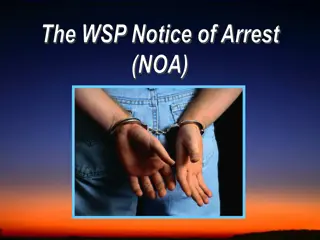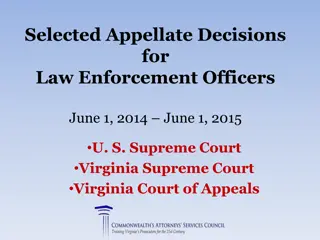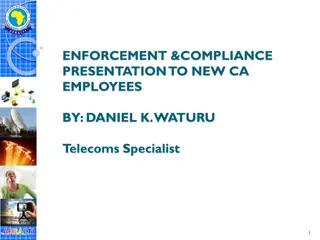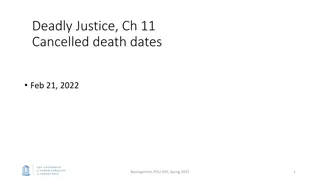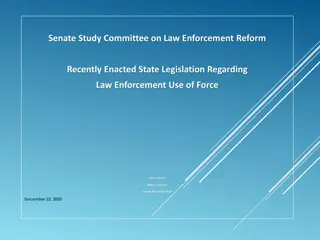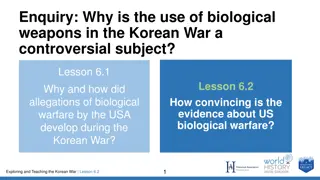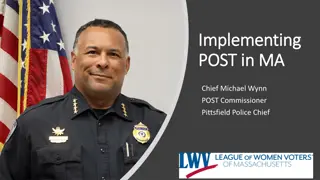Controversy Surrounding No-Knock Warrants in Law Enforcement Operations
The use of no-knock warrants has sparked debate due to tragic incidents like the killings of Kathryn Johnston, Baby Bou Bou, and Breonna Taylor. This article delves into the historical background, legal basis, arguments for and against no-knock warrants, and the fatal consequences of their execution. Recommendations for reform are highlighted in light of the conflicts between prioritizing human life and protecting evidence in law enforcement operations.
Download Presentation

Please find below an Image/Link to download the presentation.
The content on the website is provided AS IS for your information and personal use only. It may not be sold, licensed, or shared on other websites without obtaining consent from the author.If you encounter any issues during the download, it is possible that the publisher has removed the file from their server.
You are allowed to download the files provided on this website for personal or commercial use, subject to the condition that they are used lawfully. All files are the property of their respective owners.
The content on the website is provided AS IS for your information and personal use only. It may not be sold, licensed, or shared on other websites without obtaining consent from the author.
E N D
Presentation Transcript
NO-KNOCK WARRANT: HUMAN LIFE VERSUS EVIDENCE PROTECTION Jim Nzonguma Mayua Associate Professor Albany State Universty Fall 2023
AGENDA I. INTRODUCTION A. Historical Background B. Why No-Knock warrant was established II. Legal basis A. Federal regarding no-knock B. Georgia law regarding no-knock 3. MAIN ARGUMENT 3. RESEARCH QUESTION 4. ANALYSE OF DATA a. Arguments of proponents of no-knock warrant b. Arguments of opponents of no-knock warrant 5. CONCLUSION AND RECOMMENDATIONS
KILLING OF KATHRYN JOHNSTON ON NOVEMBER 21, 2006, KATHRYN JOHNSTON, A 92-YEAR-OLD AFRICAN AMERICAN WOMAN, WAS KILLED BY UNDERCOVER POLICE OFFICERS AT HER HOME IN ATLANTA, GEORGIA.
KILLING OF KATHRYN JOHNSTON Kathryn Johnston (June 26, 1914 November 21, 2006)[1]was an elderly woman fromAtlanta, Georgia who was killed by undercover police officers in her home on Neal Street in northwest Atlanta on November 21, 2006, where she had lived for 17 years. Three officers had entered her home in what was later described as a 'botched' drug raid.Officers cut off burglar bars and broke down her door using a no-knock warrant.Police said Johnston fired at them and they fired in response; she fired one shot out the door over the officers' heads and they fired 39 shots, five or six of which hit her. One of the officers planted marijuana in Johnston's house after the shooting.Later investigations found that the paperwork stating that drugs were present at Johnston's house, which had been the basis for the raid, had been falsified.The officers later admitted to having lied when they submitted cocaine as evidence claiming that they had bought it at Johnston's house. Three officers were tried for manslaughter and other charges surrounding falsification, convicted, and sentenced to ten, six, and five years, respectively
KILLING OF BOUNKHAM PHONESAVANH (BABY BOU BOU ) Police executed a no-knock raid at 2:25 am on May 28, 2014, with a SWAT team breaching a door with a ram and throwing a flash-bang stun grenade into a room containing a 19-month-old child. The grenade exploded inside the infant's playpen, igniting the playpen and his pillow, causing "blast burn injuries to the face and chest; a complex laceration of the nose, upper lip and face; 20% of the right upper lip missing; the external nose being separated from the underlying bone; and a large avulsion burn injury to the chest with a resulting left pulmonary contusion and sepsis . The search yielded no drugs, no drug dealer and no weapons; the drug dealer was arrested the next day without the use of flash-bang grenades. (Atlanta, Ga).
KILLING OF BREONA TAYLOR On March 13, 2020, Louisville Metro Police Department officers shot and killed Breonna Taylor in her apartment after being fired upon by Kenneth Walker, Breonna Taylor's boyfriend, while executing a search warrant shortly after midnight. Although the police had received court approval for a "noknock" entry, they did knock and announce themselves prior to breaking down the door, according to Kentucky Attorney General Daniel Cameron. However, Walker claims that he only heard banging on the door and no announcement.Walker fired the first shot; Walker said he fired his gun due to not knowing the intruders were police.
KILLING OF DET. CHARLES D. DINWIDDIE, May 11, 2014. Texas According to guy the thought someone was trying to break in and started shooting. Police said that guy shot 4 police officers that included the death of Charles Dinwiddie. Police never found drugs in the apartment.
KILLING OF SPECIAL AGENT LAURA SCHWARTZENBERGER 1977 - 2021 On February 2, 2021, Special Agent Laura Schwartzenberger was executing a search warrant at a suspect s home in Sunrise, Florida. The suspect opened fire on agents as they tried to breach the door. Schwartzenberger was mortally wounded, along with Special Agent Daniel Alfin. Schwartzenberger was born on July 29, 1977 in Pueblo, Colorado. She joined the FBI in December 2005.
KILLING OF DANIEL ALFIN 1985 - 2021 On February 2, 2021, Special Agent Daniel Alfin was executing a search warrant at a suspect s home in Sunrise, Florida. The suspect opened fire on the team of agents as they tried to breach the door. Alfin was mortally wounded, along with Special Agent Laura Schwartzenberger. Alfin was born on January 17, 1985 in Manhasset, New York. He joined the FBI in April 2009.
WHY THE ISSUE OF NO-KNOCK WARRANT IS SIGNIFICANT Drug offenses are not capital offenses, but a substantial number of citizens and officers lose their lives over no-knock warrants served for drugs. Reform is important
I. INTRODUCTION A. What are no-knock warrants and why are they used? A no-knock warrant is a warrant issued by a judge that allows law enforcement to enter a property without immediate prior notification of the residents, such as by knocking or ringing a doorbell. The increased use of no-knock warrants is a product of the country s war on drugs, a series of federal and local policies aimed at cracking down on recreational drug use. President Richard Nixon launched the campaign in the 1970s, but it gained momentum in the 1980s under President Ronald Reagan.
I. INTRODUCTION Use of no-knock warrants has increased substantially over time. By one estimate, there were 1,500 annually in the early 1980s whereas by 2010 there were 60,000 70,000 no-knock or quick-knock raids conducted by local police annually,the majority of which were looking for marijuana
II. LEGAL BASIS A. Federal law regarding no-knock 1. Jurisprudences A. Ker v. California, 374 U.S. 23, 83 S.Ct. 1623 (1963) ISSUE: 1) Did the warrantless entry by the deputies, without a warrant and without knocking and announcing their intent to enter, for the purpose of making a narcotics arrest, make the evidence inadmissible? 2) Were the subsequent searches of the apartment lawful? HOLDING: 1) No 2) Yes The 1963 Supreme Court ruling Ker v. California set a precedent in favor of forcible police entries involving narcotics out of concern that evidence could be destroyed.
II. LEGAL BASIS A. Federal law regarding no-knock 1. Jurisprudences b. WILSON V. ARKANSAS, 514 U.S. 927 (1995) The U.S. Supreme Court acknowledged that the fourth amendment incorporates the common law requirement that police officers entering a residence must knock on the door and their identity and purpose before attempting forcible entry to execute a search warrant. However, the Supreme Court also recognized that not every entry must be preceded by an announcement and that the fourth amendment s flexible requirement of reasonableness should not be read to mandate a rigid rule of announcement that ignores countervailing law enforcement interests
II. LEGAL BASIS b. Wilson v. Arkansas, 514 U.S. 927 (1995) The Wilson decision left it to the lower courts to determine the circumstances under which an unannounced entry is reasonable under the Fourth Amendment and simply [held] that although a search or seizure of a dwelling might be constitutionally defective if police officers enter without prior announcement, law enforcement interests may also establish the reasonableness of an unannounced entry.
II. LEGAL BASIS d. In Richards v. Wisconsin, 520 U.S. 385 (1997), The Supreme Court went on to hold that, in order to justify a no-knock entry, the police must have a reasonable suspicion that knocking and announcing their presence, under the particular circumstances, would be dangerous or futile, or that it would inhibit the effective investigation of the crime by,for example,allowing the destruction of evidence. The Court noted that, [t]his standard as opposed to a probable-cause requirement strikes the appropriate balance between the legitimate law enforcement concerns at issue in the execution of search warrants and the individual privacy interests affected by no-knock entries.
II. LEGAL BASIS A. FEDERAL LAW REGARDING NO-KNOCK WARRANTS 2. Federal statute regarding no-knock warrants 18 U.S.C. 3109 provides that an officer may break open any outer or inner door or window of a house, or any part of a house, or anything therein, to execute a search warrant, if, after notice of his authority and purpose, he is refused admittance or when necessary to liberate himself or a person aiding him in the execution of the warrant.
II. LEGAL BASIS Federal statute regarding no-knock warrants Federal agents are generally required to knock and announce their identity, authority and purpose, and demand to enter before entry is made to execute a warrant in a private dwelling. However, there are some circumstances where unannounced entries are authorized. The new policy generally limits the use of noknock entries in connection with the execution of a warrant to situations where an agent has reasonable grounds to believe that knocking and announcing the agent s presence would create an imminent threat of physical violence to the agent and/or another person.
II. LEGAL BASIS Although a federal statute previously authorized no-knock warrants for certain drug searches in the Comprehensive Drug Abuse Prevention and Control Act of 1970, Congress repealed that provision in 1974. The no-knock experience lasted four years and demonstrated the inevitability of many of the dangers foreseen in 1970. During the four-year period when no-knock warrants were issued, horror stories were legion. Over one hundred newspaper articles, reproduced in the Congressional Record, described a repeated scenario: terrified citizens, thinking themselves targets of burglary or more frightening acts, discovered that they were instead being searched by law enforcement officers who had entered their homes without notice.
II. LEGAL BASIS B. Current law in Georgia regarding no-knock warrants O.C.G.A. 17-5-27 states that: All necessary and reasonable force may be used to effect an entry into any building or property or part thereof to execute a search warrant if, after verbal notice or an attempt in good faith to give verbal notice by the officer directed to execute the same of his authority and purpose: (1) He is refused admittance; (2) The person or persons within the building or property or part thereof refuse to acknowledge and answer the verbal notice or the presence of the person or persons therein is unknown to the officer; or (3) The building or property or part thereof is not then occupied by any person.
II. LEGAL BASIS B. Current law in Georgia regarding no-knock warrants However, as the Court of Appeals of Georgia has noted, where the State demonstrates a reasonable suspicion that knocking and announcing the officers presence would be dangerous or futile under the particular circumstances, or that it would hinder the effective investigation of the crime by, for example, allowing the destruction of evidence, a no-knock entry may be authorized. Furthermore, the standard for establishing the reasonable suspicion necessary to justify a no-knock entry, as opposed to the standard for establishing probable cause, is not high.
IV. RESEARCH QUESTION How does the no-knock warrant balance between priority of life and the need to protect evidence? Does the no-knock warrant serve the government legitimate purpose?
MAIN ARGUMENT Our society needs to place the lives of its people above the acquisition of drug evidence.
4. ANALYSE OF DATA A. arguments of proponents of no-knock warrant Prevent suspects from fleeing, Help preserve evidence, and/or Protect the safety of innocent parties or officers,
4. ANALYSE OF DATA B. Controversy about no-knock warrant There have been cases where burglars have robbed homes by pretending to be officers with a no- knock warrant. There have been many cases where armed homeowners, believing that they are being invaded, have shot at officers, resulting in deaths on both sides. The act of entering someone's home by surprise, often late at night or early in the morning, creates a risk of violence, especially given the prevalence of gun ownership in United States. While it is legal to shoot a homeowner's dog when an officer fears for their life, there have been numerous high-profile cases in which family pets lacking the size, strength, or demeanor to attack officers have been shot.
5. STATISTICS ABOUT NO-KNOCK WARRANT A. No-knock warrant does not serve the government legitimate goal There are no statistics showing that no-knock warrant tactic has decreased the drug offenses. We analyzed the highest drug use by state , we found that the top ten are states that use No-knock warrant (New Mexico, West Virginia, DC, Louisiana, Colorado, Missouri, Arkansas, Nevada, Oklahoma, Michigan). 20,000 no-knock raids executed in the U.S. each year.
5. STATISTICS ABOUT NO-KNOCK WARRANT B. Innocent people killed We see about 8 to 10 cases per year where a completely innocent person is killed among these raids. C. People who have some drugs in the house We another 20 or 30 where someone who, may have had some drugs in the house is killed From 2010 through 2016, at least 81 civilians and 13 officers died during SWAT raids, including 31 civilians and eight officers during execution of no-knock warrants.
No-knock warrants may be issued in every state except Oregon (prohibited by state law), Florida (prohibited by a 1994 state supreme court decision), Virginia (prohibited through legislation passed in 2020), and Tennessee (prohibited through legislation passed in 2021). Connecticut,
WHEN CAN HE USE officers may lawfully conduct searches and seizures in the case of emergent exigent circumstances. reserving them for only the most dangerous and urgent situations.
CONCLUSIONS AND RECOMMENDATIONS There are several other considerations law enforcement leaders need to evaluate that directly impact the risks created during dynamic no-knock raids in contemporary times: The proliferation of guns in households across the country. In 2020 and 2021, Americans bought over 42 million guns. Residents awakened from their sleep by the sounds of someone breaking into their home could reasonably reach for their legally owned firearms to defend themselves, leading to tragic consequences for occupants and officer
CONCLUSIONS AND RECOMMENDATIONS No-knock conflicts with the right to self-defense, your-ground laws, and the castle doctrine. The common law principle of castle doctrine says that individuals have the right to use reasonable force, including deadly force, to protect themselves against an intruder in their home. Georgia Law on the Use of Force in Defense of Self or Others Official Code of Georgia Annotated (O.C.G.A.) 16-3-21 outlines this defense and when it is accepted and when it is not. When people feel threatened or even see another being threatened, sometimes the reaction is to use force to defend and occasionally, deadly force. Essentially, two elements that must be present before the use of deadly force is justified: The danger to either himself or a third person must be imminent; and He must reasonably believe that such force is necessary to prevent death or great bodily injury to self or a third person.
CONCLUSIONS AND RECOMMENDATIONS The risk of a mistake-of-fact shooting. The facts of Kathryn Johnston, BABY BOU BOU cases serve as an example of this type of risk. The search yielded no drugs, no drug dealer and no weapons
CONCLUSIONS AND RECOMMENDATIONS Technology advances and warning systems. The shooting of two FBI agents, Special agents (Laura Schwartzenberger and Daniel Alfin) in Florida in 2021 is an example of this issue. The target of the warrant was allegedly warned of their approach by a doorbell camera. This warning allowed him to fire at the agents through his door with a high-powered rifle Insufficient information about the residence and its occupants. Many civil cases have arisen from raids on the wrong address, or the correct address but the targets had moved out, or lack of information on the presence of children in the residence, leading to flashbangs being deployed in and around young children
CONCLUSIONS AND RECOMMENDATIONS Failure to properly supervise specialty narcotics units and warrant applications. The unfortunate truth is some specialty units become so consumed by their mission that they believe the ends justify the means. This can lead to overaggressive tactics and warrant services. It also can lead to officers lying or exaggerating information on warrant applications, as allegedly happened in the Breonna Taylor incident.
CONCLUSIONS AND RECOMMENDATIONS Failure to adhere to a proper Priority of Life. This is probably the most important consideration, and everything discussed in this article so far is relevant to it. The National Tactical Officers Association (NTOA) has long established safety priorities: 1. Hostages/victims 2. Innocent bystanders 3. Public safety personnel (police, EMS, fire) 4. Suspect(s) 5. Drugs/evidence (Controlling objective) Using these safety priorities, the NTOA has taken the position for some time now that no-knock warrants no longer make sense, especially when the objective is the preservation of evidence. I strongly agree with this position. Most no-knock warrants for drugs essentially place the preservation of evidence over the safety of anyone else including police officers.



